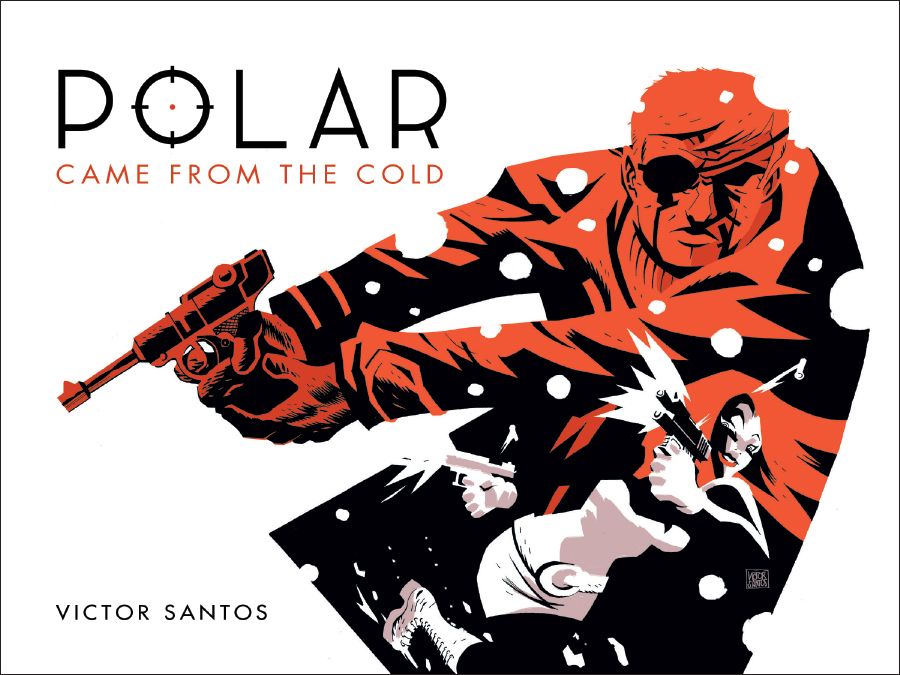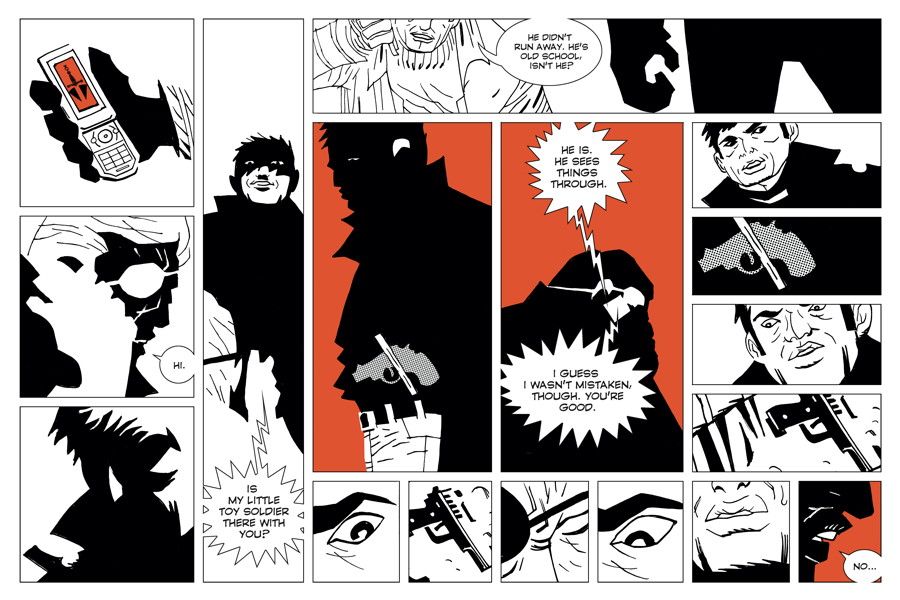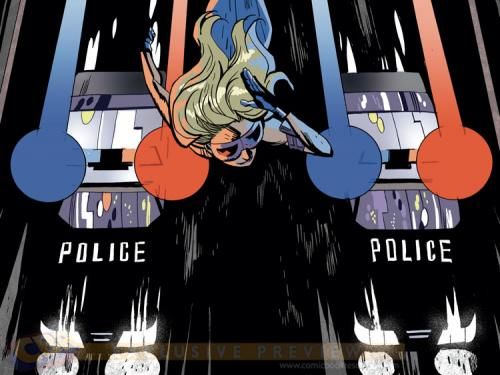Long before we worked together, I respected Kevin Melrose's instincts on picking creators to watch. So when he advised the Robot 6 audience to read Victor Santos' webcomic Polar, I was intrigued. That interest only grew when Jim Gibbons (one of the best editors working in comics) told me Dark Horse was collecting Polar's first season in Polar: Came from the Cold (which ROBOT 6 previewed in late September); I knew I wanted to interview the Bilbao, Spain-based artist.
In addition to discussing the 160-page Polar hardcover, set for release on Dec. 11, we also touched upon the upcoming Furious, a Dark Horse miniseries with his Mice Templar collaborator Bryan J.L. Glass, set to launch on Jan. 29. (For additional Furious information, please read Albert Ching's September interview with Glass.)
Tim O'Shea: You are very clear at your website in terms of the influences that inform Polar: Came from the Cold. "The story uses a minimalistic and direct style inspired by movies like Le Samurai (Jean-Pierre Melville, 1967), Tokyo Drifter (Seijun Suzuki, 1965) or Point Blank (John Boorman, 1967) and novels like The Killer Inside Me (Jim Thompson, 1952) or The Eiger Sanction (Trevanian, 1979). Polar is also a tribute to artists like Jim Steranko, Jose Muñoz, Alberto Breccia, Alex Toth and Frank Miller." I would love to discuss each and every element of those sentences, but I will just focus on two elements. How did you first find out about films like Le Samurai? When did you read your first Steranko story, and what was it?
Victor Santos: The first Steranko book I read was the Outland adaptation. I was studying fine arts, and I hadn't really had a great deal of exposure to U.S. comics. I’d read a lot of superheroes books in my childhood, but the manga explosion of the '80 and '90s caught me just in my teenage years. Actually, it was during my university years when I discovered the great U.S. artists like Eisner, Ditko, Crumb, Toth, Caniff and dozens more (thanks to friends I met there, never the professors). I discovered an old Spanish edition of Outland in a street market. Wow, that stuff blew me away! The big panels contrasting the little panels, as well as that “heavy black lighting” ... This edition was a big, European album size, so the double-page spreads are gigantic. I began to research. These were very intense years for me; I was absorbing all the American history of comics at the same time.
About Jean-Pierre Melville's Le Samurai, it happened during the same years. I met a guy in a cinema class (today he's one of my best friends) and we both were huge fans of John Woo. We would spend the classes repeating the same dialogue from The Killer or Hard-Boiled. He talked to me about this movie and how it was the inspiration for 1989’s The Killer. Another shock: It was the same story, the same main character ... but the approach was absolutely opposite: cold, distant and stoic.
In comic book storytelling it is easier to play John Woo style, more cartooning, emotions running high. In The Mice Templar it works really well because we move in an epic territory. But it's really hard to involve a reader/watcher, using Melville style.
How did Polar end up being collected by Dark Horse?
Since I began the story, I’d hoped to collect it. When I finished the first season, I added some pages and corrected some mistakes or unsatisfactory parts and made a PDF with all the stuff and a brief explanation of the purpose. I wrote a list of suitable publishers, places with creator-owned titles and contacts from Spain, France and USA. Dark Horse was the first on my list but my only contact was with Jim (Gibbons), my editor, because a of Dark Horse Presents story I did with Mike Oeming (The Sacrifice). I sent it to him thinking: “OK, contact the favorite cool publishers first." But like a mere formality. I was really, really lucky.
In terms of the development of the story, before you even drew the first page, did you already know red would be the most dominant color in the story?
Initially, yes. I used a red marker in the sketch stage. I ink this stuff differently than other works, it's like a jigsaw. I'm not thinking in terms of figures or specific drawings but about big areas of black, white and red. In comic books I think “How does the reader's eye move across the page?” but in Polar, each page is like a single shot to the reader's eye.
That was my first thought, but when I scan and use the computer for these red areas, sometimes I insert changes. I try to get some kind of balance.
The original webcomic was wordless, but for the Dark Horse collection, dialogue has been added. Was that a change you were reluctant at all to do?
Before the DH approval, Jim was honest with me about the commercial danger of a silent book, but at the same time I had the dialogued version in mind. In Spain I have published a lot of books as complete author (both writer and artist); I even have written books for other artists. I was frustrated because my career in the U.S. was only as an artist and I love to write. But writing in English was a challenge.
At the same time the website is done and there for a quick reading -- immediate consumption. But I think in books the pacing must be slower and the dialogue is a way to drive the reader. And a useful tool for enriching the background of the characters, of course.
Speaking of the dialogue, without spoiling the story too much, can you pick out a favorite line of dialogue? For me, it is early on in the story, when Black Kaiser catches one of the folks sent to kill him. The captured assassin says: "I won't tell you anything." And Black merely replies: "I won't ask." right before killing the fellow.
Thank you! I'm never satisfied, but reading my own stuff, trying to get an objective perspective, I always “save” some sentences. These moments when the prose is so refined you can say a lot of things with few words. I like that moment too, because you learn a lot about the life and relationships of these guys, these hit men. They don't expect, they don't hope.
I'm also pleased with the dialogue with the gunsmith girl: “It's cold outside, you know.” He answers: “I know. It'll get worse.” It's a very romantic situation! But these people don't talk about feelings. They speak about different matters. She says “Stay with me” but Black Kaiser's mind is far away, focused on the upcoming killings. I love the English language because this stark style works better. In Spanish we use too many long words.
One last question on dialogue, one character in particular has a unique lettering style for when he speaks. How did you arrive upon that approach (which I love)?
I'm not sure ... I was thinking about some of these daring experiments of 80s mainstream books I love, like The Question by O'Neil and Cowan or the Shadow and Daredevil sagas drawn by Bill Sienkiewicz. These crazy artistic experiments. If when I drew the scenes I was thinking of taking advantage of the marvelous storytelling of the comic page. Why should I not follow the same philosophy with the lettering? Originally, the redheaded woman, Miss Vian, had a different font too. I wanted something cursive suggesting a silky voice -- but I didn't find an appropriate way. It was far too confusing.
Were other major changes or improvements made for the Dark Horse edition?
I added a few pages more because some dialogue needed more space. And I made a different edit. In total I added nearly 25 pages and a bonus short story. Some pages have a different order than the webcomic. I had a clear vision in my mind that the books should be a different experience. It's like a movie adaptation or a novelization. On the web, you see a unique page, but in the books you must think of how the composition of a page alters its opposite, and placing the surprises on the even-numbered pages.
I loved your use of satellite technology at certain points in the story, what prompted that element?
It's funny because when I created Polar I wanted to give it a very '70s look ... suits, sideburns and this bad go-go girl with miniskirt and boots -- but at the same time I didn't want to reject the storytelling possibilities of modern technology: cells, satellite, the cloud storage. And modern themes like the privatization of the government agencies. So the series moves through an anachronistic universe. Well, really it's our universe, but with a '70s sense of fashion.
In the book's dedication, you mention a number of people, but one line sticks out to me. "And to Mark Buckingham, my pathfinder." Can you talk about the impact that Buckingham has had on you?
I met Mark at a Spanish convention 10 years ago, in Avilés. It's funny because we met our future spouses there that year. He moved to Spain some years ago and we would run into each other at cons, became friends. He helped me a lot, I traveled with Mark and his lovely wife to cons like Bristol -- he introduced me to authors and editors. We joke that I consider myself his “padawan.”
He's not only a nice guy and a good person, he's an example of the kind of professional I want to become. He has never lost his passion for comic books. He's still a reader, a fan. I'm sick of listening to sourpuss authors complaining about how tired they are, how they consider comic books simply a business. So here you have a guy who works a lot and still loves it.
I have been very lucky and proud to meet people like Mark or Mike Oeming and Brian Azzarello. People who helped me and guided me.
Let's talk about Furious, your upcoming miniseries with Mice Templar writer Bryan J.L. Glass. I happened to chat with him a few months ago at Baltimore Comic-Con -- he showed me some of your pages. They left me speechless, but more about that in a minute. First off, you do not traditionally draw superhero stories, what was it about Glass' script that convinced you to do this?
Well, honestly nobody offered me a superhero title before. Years ago I went to Spanish cons where Marvel or DC did talent searches but I always had problems with my style. One DC editor was very honest with me: “You are very talented, but right now you couldn't draw a Batman or a Superman big title. We must find a specific style.” I don't know why sometimes in superheroes titles it's easier to find work if you are a bad clone of a hot artist, rather than if you have a modicum of personality [in your work]. But then readers are pleased with [unique artists like] Mike Allred, David Aja or David Lafuente. Well, if you introduce some variety, more cool comic books will appear!
I love superheroes. It's like the Western genre for the cinema. You can draw and write a thousand western novels, and they’ll never work as well as in a movie. You can film a thousand superhero movies with billions of dollars: a movie never will work as well as a comic book. Superheroes were born to be drawn.
I'm not a big fan of sagas or characters, but I'm devoted to those people who wrote and drew them. My home is full of incomplete collections because I only care about who did them. Daredevil doesn't exist to me. Miller’s Daredevil, Colan's Daredevil, or Brubaker's Daredevil exists to me... So I was happy with Furious because Bryan offered me the chance to draw Bryan and Victor's Furious.
Back to the pages I saw: You have one scene that pops off the where the lead character is flying above police cars and you allow the blue and red streaming lights off the police car to frame the character? What prompted you to try such a dynamic approach with that scene -- and did you struggle with the best way to pull that off?
I must say that scene never would have existed without the art of Walter Simonson. In that university period when I observed all the storytelling in U.S. comics, I read his Thor. His iconic use of light and sound effects ... Wow this was so avant-garde and iconic! Why did we lose this? I'm not an old reader who misses the good old times of golden age, I was a teenage manga reader who discovered U.S. comic books with fresh eyes. In that scene, I could have used a Photoshop airbrush and some cinematic effects -- but that would be so boring! This is a drawing, damn it! I can use a circle of pure red and show how this pure color will work on the body of the character! To find these storytelling solutions is what makes it so fun to draw superheroes.



